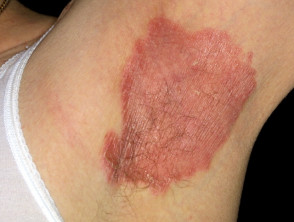 Inverse psoriasis is a type of psoriasis that occurs where there is skin-to-skin contact, such as the armpits, the buttocks, the belly button, the inner thighs, under the breasts, and in other skin folds. It is sometimes referred to as "skin-fold psoriasis" or "flexural psoriasis".
Inverse psoriasis is a type of psoriasis that occurs where there is skin-to-skin contact, such as the armpits, the buttocks, the belly button, the inner thighs, under the breasts, and in other skin folds. It is sometimes referred to as "skin-fold psoriasis" or "flexural psoriasis".
The lesions of inverse psoriasis are generally red, smooth, and shiny. Because inverse psoriasis appears in moist areas where the typical dry scale of psoriasis does not form.
Many people with inverse psoriasis will have another type of psoriasis elsewhere on their body at the same time.
Treatment of Inverse Psoriasis
Treating psoriasis within skin folds with topical medications is often challenging. The skin there tends to be more sensitive, can absorb excessive amounts of medication, and is prone to fungal infections.
For instance, topical retinoids or calcipotriene applied in areas of skin folds can be irritating. Similarly, a topical corticosteroid applied to the groin increases the risk of skin atrophy (thinning of the skin) and of developing a fungal skin infection.
Different medications may be tried for the treatment of inverse psoriasis, sometimes at lower-than-normal concentrations, including coal tar, and anthralin. Calcineurin inhibitors (Elidel®, Protopic®) are used commonly to treat atopic dermatitis, but have also been found to be effective in the treatment of inverse psoriasis.
If topical corticosteroids are prescribed, an anti-fungal medication might also be recommended to prevent the development of fungal skin infections, such as ringworm (tinea capitis).
Some vitamin D derivatives, such as calcitriol (Vectical®), may be less irritating to the sensitive skin folds.
Severe cases may require treatment with systemic medications.
Image Source: DermNet NZ
Source: Vivacare
Last updated : 7/19/2021